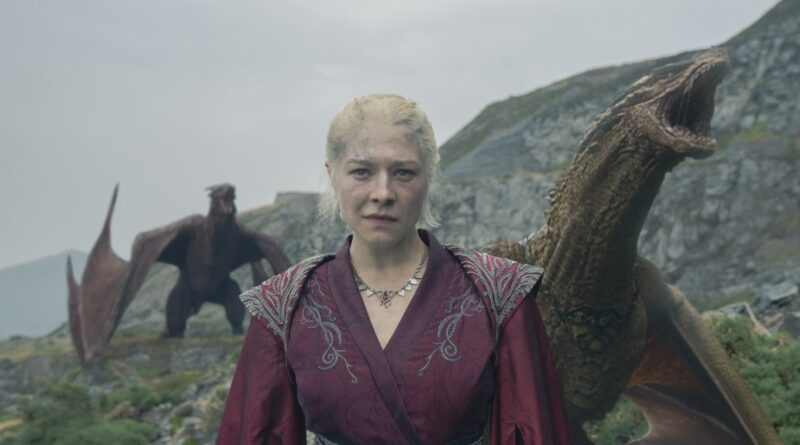House of the Dragon Season 2 Review
I’ll admit it: I didn’t watch Game of Thrones. In fact, I’m reading the books so I can be annoying to those who have. Even to a non-viewer, it was plain to see that the franchise was on ice after the flagship show’s disastrous final seasons. House of the Dragon, (or HotD if you’re nasty), is a prequel adapting parts of George R.R. Martin’s Fire & Blood that takes place nearly two centuries before the main show, and this past summer, it finished its second season. For many, HotD’s first season was a return to form. The wonders of Martin’s meticulously crafted fantasy world were on full display as soaring dragons and deadly political schemes graced our televisions once again. Now fans ask the grave question: does the second season stack up, or does it suffer a sophomore slump?
My spoiler-free review of this season is that I’m very mixed. While I appreciate that they slowed the pace down to focus on character and atmosphere, this season fails to deliver on all of its set up. It’s lopsided, which means that there are just as many great moments as eyebrow-raising ones. Ultimately, you get out of this show what you put in. It’s a richly rewarding experience when you give it the attention it deserves. So get some HotD of your own; I definitely recommend the show despite its shortcomings.
After this point, I’ll be getting into the nitty-gritty, so expect full spoilers for both seasons of House of the Dragon.
SPOILERS BELOW
(and trigger warning for discussion of sexual abuse)
Before I really get into it, it must be said that this season was heavily impacted by HBO’s meddling and 2023’s SAG-AFTRA writer’s strike. This season was supposed to be 10 episodes, like the previous one, and was shortened to 8, but work continued during the strike (and it shows). This information radically recontextualized how I felt about the season. Suddenly, everything made sense. The awkward pacing, the finale’s anticlimax, the strange editing that was clearly done to stretch out footage—this season is blatantly unfinished. That’s not the fault of the writers, that rests solely on HBO, because if there were 10 episodes, half of my critiques of this season wouldn’t exist. In a way, I was relieved, because knowing this season was made out of compromise and circumstance not only allows me to better understand its greatest flaws, but better celebrate its triumphs.
I can’t speak on HotD as an adaptation, but I know someone who can. On September 4th, George R.R. Martin updated his blog with a post regarding his thoughts on the season. The post, which included spoilers for both Fire & Blood and the third season of HotD, was taken down mere hours after its release. Having read it beforehand, I can tell you that Martin’s frustration with the writing laid in a single character’s removal (Maelor “the missing,” as he put it), and since the man has Westeros’ history tattooed on his brain, he takes issue with the butterfly effect of that decision going forward. Digging deeper, it looks as though he felt slighted by the disregard exhibited for the source material. Seeing as how Martin had heaps of praise for the early episodes of season 2, it comes as a shock, but as the season progressed, even I could see that the book and the show were taking two divergent routes to a destination that even book fans find unclear. Martin and I share the same critique: the show might understand the plot and story, but not the ethos. It knows the what, but not always the why.

Even when HotD drives me up a wall, I remember how easily its world seduced me. Westeros has never looked so vibrant and alive than it does here, which is entirely due to the excellent craftsmanship of the sets and costuming. The cramped, volcanic halls of Dragonstone, claustrophobic with tight shelves of scrolls, serves as Team Black’s HQ, and Harrenhal, which Thrones fans will recognize, embodies the ancient spookiness of the Riverlands and the North’s old gods. The color coding for Team Black and Team Green’s clothes can be a little silly, but nobody can deny that they’re stunning. Aemond (Ewan Mitchell) sports tight green leather that oozes 80’s horror allure when paired with his nasty eyepatch and scar, while Rhaenyra (Emma D’Arcy) has regal Valyrian drip that serves Sith Lord realness. Even a picky book enjoyer like me is satisfied with how authentically Westeros was rendered. Getting to see more book accurate depictions of Essos, God’s Eye, and never-been-seen deep cuts like the Green Men, are nice touches, even if they’re small.
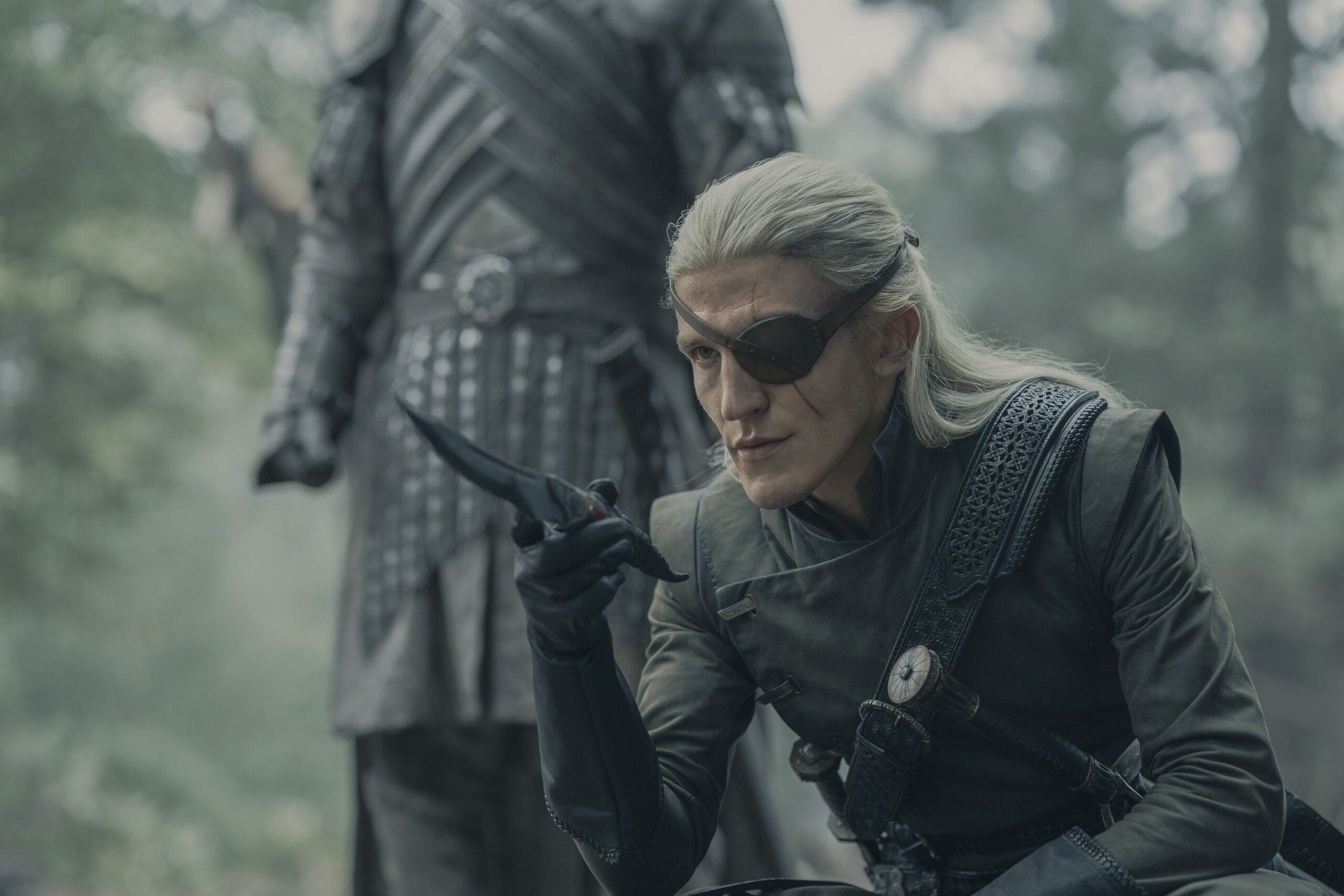
The small stuff is where the season excels; it’s the macro that it struggles with. The elephant in the room this season is the pace. I, for one, welcomed a slower pace, since, for me, season 1 was far too fast. It’s hard to care about this latest birth, death, wedding, or funeral when there’s already been eleven this season. Season 2 was wise to slow down the pace to explore all these characters it has on its hands. The audience can really settle into the status quo of the season and enjoy the slow-burning character work, but all the threads suffer from repetition and wheel-spinning. Episode 1 effectively sets them all in motion, and as each one progresses, it’s clear to see how they’ll eventually fold in on one another, but unfortunately, they never converge as they should. The season’s plot isn’t the strongest. Outside of a few bombastic examples, like episode 4’s dragon battle, most of the season’s greatest achievements are understated character moments.
Rhaenyra’s journey, starting at a place of attempting every possible path to peace but eventually arriving at becoming a quasi-religious leader of a dragon cult to arm her side with the most flying nukes, was well-earned. Emma D’Arcy is iconic in this role, and their decision to make Rhaenyra canonically queer makes good on the show’s themes of gender and sexuality. Placing season 1’s worst character, Mysaria (Sonoya Mizuno), on Dragonstone to pair her with Rhaenyra, a consistently engaging scene partner, was a stroke of genius, and improved a character I thought was unsalvageable. That’s no shade to the actress, only how misused she was previously. Unfortunately, you can tell that Rhaenyra and Mysaria’s kiss was improvised by the actors and not an intentional writing move, since the two are barely in a scene together afterward, and their relationship isn’t referenced at all.
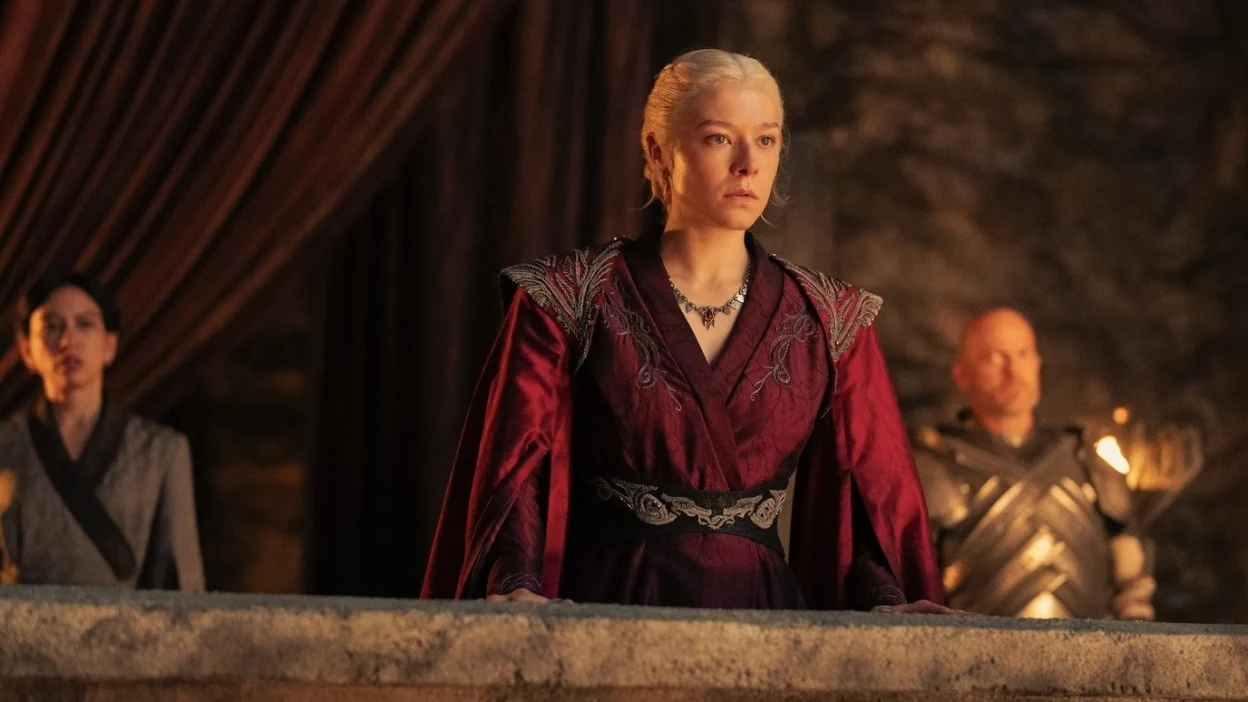
The best plotline this season was Daemon (Matt Smith) at Harrenhal. Daemon is defined by his charisma, fighting ability, and Targaryen elitism, so placing him in a different culture that has little respect for his Targaryen blood, on a primarily diplomatic mission, and surrounding him with characters that challenge his ego, was the perfect way to deconstruct his character. Harrenhal’s supporting cast is a joy. Alys Rivers (Gayle Rankin) brings a refreshingly woodsy, witchy energy compared to the dragon-focussed mysticism of the Targaryens. Simon Strong (Simon Russel Beale) is a delightful old fellow who welcomes Daemon into his castle, and seems pretty chill about living in a haunted house. The young Oscar Tully (Archie Barnes) holds his own against Daemon and challenges his wanton use of violence to achieve his ends in the Riverlands. At Harrenhal, the writing truly feels like it was approaching the quality of George R.R. Martin’s own pages.
It was Team Green that really disappointed me this season. I understand that it’s thematic and plot related that the Greens are all emotionally stunted freakazoids with crippling hangups about duty and sexuality that prevent them talking about their feelings, but it was increasingly hard for me to emotionally engage with them. This season has been too content for subtext to be text. Subtly is appreciated, but not always required. For example, episode 6, “Smalkfolk,” (my favorite episode), features a scene in which Alicent is talking with her brother Gwayne (Freddie Fox). She asks about her son Daeron, who is being raised far away in Oldtown, and Gwayne assures her that he’s a good kid. He’s kind. It’s clear that it equally hurts and gladdens Alicent that the one son she didn’t raise turned out alright. It’s my favorite scene this season, since it actually explores these characters through interesting and emotionally engaging interactions that not only enriches the audience’s understanding of the characters, but the characters’ understanding of each other.
Despite my bellyaching, Team Green easily has the best performances. Rhys Ifans as Otto Hightower has an Emmy incoming for his blisteringly good scene with Aegon (Tom Glynn-Carney) in episode 2. Olivia Cooke as Alicent brings a melancholic mania to the character that truly accentuates the pointlessness of this conflict and system. Fabien Frankel also infuses a similarly, yet more pronounced, unhinged shellshock in Criston Cole. By far the most surprising performance is Tom Glynn-Carney as Aegon.
Aegon is a bad person. We know he severely bullied his younger brother Aemond and raped a royal servant named Dyana. He’s also fathered bastard children that he’s left to languish in the streets of Kings Landing and watches them kill each other in child fighting rings. Despite being pure evil, Glynn-Carney is able to open the door for the audience to be invested in Aegon as he navigates his new role as king, and after Aemond blasts him with dragon fire, the painful recovery from his burns.
On the other hand, I fail to see why Aegon is given more screen time and sympathy than his victims. Aegon is a serial sexual abuser, and one of his victims is his brother, but the narrative makes Aemond into its most villainous presence out of a simple need for one, while Aegon is seen as his victim. HotD wants to critique unfair sex and gender norms inside the confines of oppressive institutions, yet humanizes the greatest perpetrator of systemic abuse. The narrative sets up the system to be the real villain…except when Aemond needs to be the villain. This speaks to the ethos problem I diagnosed the show with. Narratives like this in Martin’s work, such as Jaime Lannister’s, only succeed if the subject character actually has goodness in them, which Aegon does not.
I would have loved to talk about Corlys, Rhaena, and Jace, but my review, like this show, doesn’t have enough room for all these characters. Instead, I’ll move onto the biggest source of contention this season: the finale.
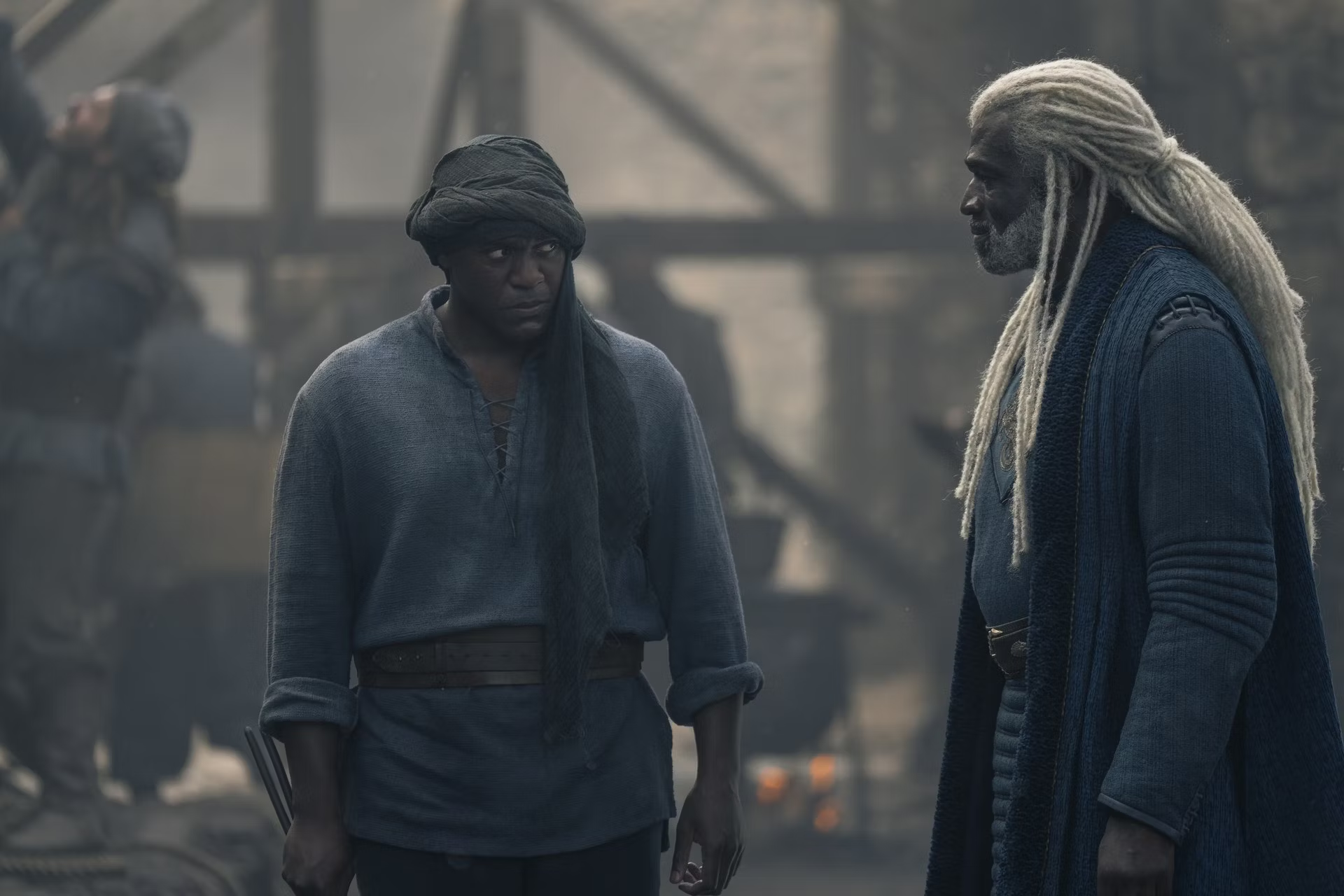
It’s unfortunate, to say the least. It’s really not a finale, since the oncoming battles at Harrenhal and the Gullet have been moved to season 3, literally removing the climax to all the arcs that built up to them. Beyond this, Daemon’s CGI weirwood vision initially bounced right off me. Throughout this season, I never liked how the Blacks were positioned as not just protagonists, but heroes, as the Greens became more villainous. Daemon fighting for the prophesied future instead of anything personally motivating is a strang, self-harming choice. Oh, and the Danaerys cameo was a bit much. Nevertheless, I have faith that it’ll come back around. Team Black thinking themselves prophesied heroes will surely be their downfall, as prophecy in Martin’s work has never been clear-cut, and those that cling to it are punished.
This season had very high highs and very low lows, but it’s hard to hold that against the writers or anyone involved creatively. They didn’t want it to be like this, and my heart aches for them. That’s not to say the show doesn’t have flaws irrespective of HBO’s meddling, but those are easier to swallow. Nevertheless, what we do have is a perfectly laid landing strip for season 3 to take off from. Maybe George R.R. Martin has lost hope for this show, but I haven’t. I’ll be seated for more Targaryen antics for seasons to come.

